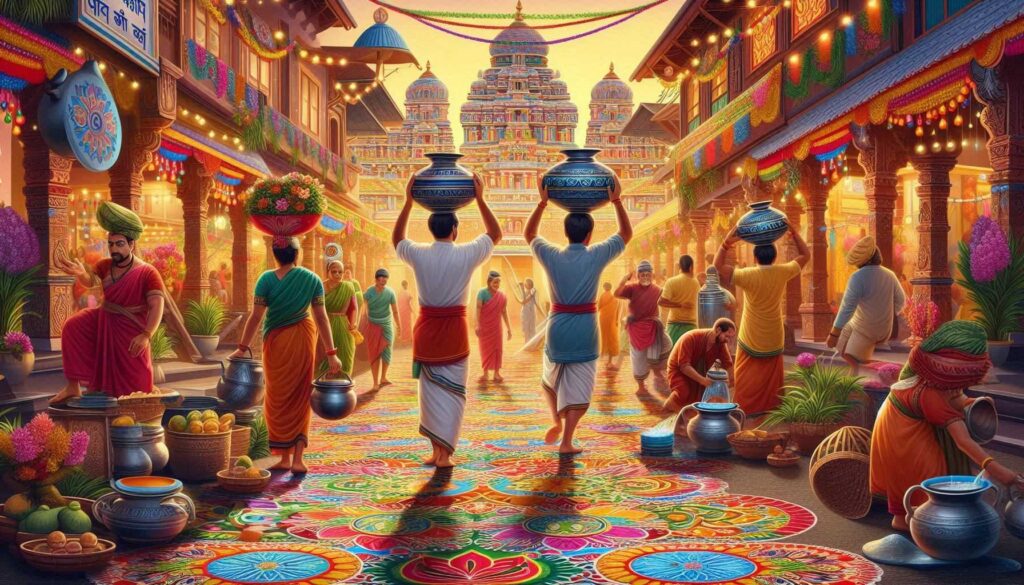Festivals in Jammu and Kashmir in July 2025
Jammu and Kashmir, often referred to as “Paradise on Earth,” is rich in cultural diversity and spiritual heritage. The month of July 2025 brings a series of vibrant festivals that reflect the region’s deep-rooted traditions, unyielding faith, and community spirit. From significant Hindu pilgrimages to local celebrations, these festivals embody the essence of Jammu and Kashmir’s cultural tapestry. Below, we delve into the key festivals celebrated in this picturesque region during July 2025, highlighting their rituals and significance.
Read More About Hindu Philosophy
1. Amarnath Yatra

Date: July 2025 (Exact dates to be confirmed based on the Hindu calendar)
Overview: The Amarnath Yatra is one of the most revered Hindu pilgrimages, dedicated to Lord Shiva. Every year, thousands of devotees undertake this arduous journey to the Amarnath cave, where a naturally occurring ice lingam symbolizes Lord Shiva. The yatra holds immense spiritual significance, representing faith, endurance, and devotion.
Rituals:
- Preparation for the Journey: Devotees begin their preparations weeks in advance. They gather necessary supplies, including food, water, and religious items, and often attend special prayer sessions in local temples.
- Trek to Amarnath: The yatra typically commences from Pahalgam or Baltal. Pilgrims embark on a challenging trek of approximately 30 kilometers, often lasting several days. Many perform puja (worship) at various stops along the way, seeking blessings for a safe journey.
- Worship at the Cave: Upon reaching the cave, pilgrims perform rituals that include:
- Abhishekam: Offering milk, honey, and ghee to the ice lingam.
- Chanting Mantras: Reciting sacred hymns and mantras dedicated to Lord Shiva, fostering a meditative atmosphere.
- Pradakshina: Circling the lingam in reverence, symbolizing respect and devotion.
Cultural Significance: The Amarnath Yatra is not just a pilgrimage; it is a journey of self-discovery, faith, and community. The event unites people from diverse backgrounds, fostering a sense of belonging and shared spirituality.
2. Ashada Purnima (Guru Purnima)

Date: July 21, 2025
Overview: Guru Purnima, also known as Ashada Purnima, is a sacred day dedicated to honoring gurus (teachers) and the spiritual lineage. It is celebrated by Hindus and Buddhists alike, reflecting the profound respect for the guidance and wisdom imparted by spiritual teachers.
Rituals:
- Morning Rituals: Devotees typically begin their day with a bath, followed by prayers to their gurus. Many people create a special altar adorned with flowers, fruits, and sweets.
- Offering of Gratitude: It is customary to offer items such as:
- Flowers and Fruits: Symbolizing respect and gratitude.
- Sweets: Traditional sweets are often prepared and offered to the gurus, signifying joy and celebration.
- Recitation of Scriptures: Many devotees read scriptures or texts related to their guru, such as the Guru Gita, reinforcing their teachings and wisdom.
- Kirtan and Bhajans: Community gatherings often include singing devotional songs (kirtan) dedicated to the guru, creating an atmosphere of devotion and joy.
Cultural Significance: Guru Purnima reinforces the importance of knowledge and learning in Hindu culture. It serves as a reminder of the contributions of spiritual guides in shaping one’s understanding and perspective on life.
3. Shravana Masa (Shivratri)

Date: Various dates in July 2025 (check local calendars for specific observances)
Overview: Shravana Masa is a month dedicated to the worship of Lord Shiva, with specific rituals culminating in the celebration of Shivratri. This period is particularly significant for devotees who engage in various forms of worship and fasting.
Rituals:
- Fasting: Many devotees observe strict fasting throughout the month, avoiding grains and consuming only fruits and milk.
- Daily Worship: Each day, devotees perform puja at home or in temples, which includes:
- Offering Bilva Leaves: These leaves are sacred to Shiva and are offered during prayers.
- Lighting Lamps: Devotees light lamps and incense sticks to create a sacred ambiance.
- Shivratri Celebration: The culmination of the month includes a grand celebration on the day of Shivratri:
- Night Vigil (Jagaran): Devotees keep vigil throughout the night, singing bhajans and chanting mantras in reverence to Lord Shiva.
- Abhishekam: Rituals involve bathing the Shiva lingam with milk, honey, and water, accompanied by the recitation of sacred texts.
Cultural Significance: Shravana Masa deepens the bond between devotees and Lord Shiva, promoting spiritual growth and self-reflection. The rituals foster a sense of community as people come together in worship and celebration.
4. Sankashti Chaturthi

Date: July 17, 2025
Overview: Sankashti Chaturthi is dedicated to Lord Ganesha, the remover of obstacles. Observed on the fourth day after the full moon, this festival is particularly significant for those seeking success and overcoming difficulties.
Rituals:
- Morning Fasting: Devotees begin their day with a fast, abstaining from food until the moon is sighted. They engage in meditation and prayers, focusing on Lord Ganesha.
- Prayers and Offerings: Common rituals include:
- Idol Worship: Devotees create a small altar with a Ganesha idol, decorating it with flowers and offerings like modaks (sweet dumplings).
- Reading the Sankashti Vrat Katha: This sacred story narrates the significance of the festival and the blessings received by devotees who honor Ganesha.
- Moon Sighting: After sighting the moon, devotees break their fast with a prayer and a simple meal, often sharing food with family and friends.
Cultural Significance: Sankashti Chaturthi highlights the importance of faith in overcoming life’s challenges. The festival reinforces the belief in Ganesha’s ability to clear obstacles, promoting positivity and resilience.
5. Other Celebrations and Observances in Jammu and Kashmir
In addition to the major festivals, several local traditions and observances take place in July, enriching the cultural landscape:
- Purnima Fasts and Rituals: Many Hindus observe fasts on full moon days, engaging in pujas and community gatherings.
- Regional Agricultural Festivals: July marks the beginning of the agricultural season. Local communities celebrate with traditional folk dances, music, and feasts, emphasizing gratitude for the harvest and prayers for a bountiful year.
Conclusion
The festivals of July 2025 in Jammu and Kashmir represent a rich tapestry of traditions, rituals, and spiritual connections that continue to thrive in this beautiful region. Each celebration reflects the deep-seated values of community, faith, and reverence for the divine. By participating in these festivals, devotees not only connect with their spiritual roots but also strengthen communal bonds, fostering a sense of unity amidst diversity.
As you explore these festivals, remember that each ritual, each prayer, and each gathering is a celebration of life, love, and spirituality. Whether you’re participating in the Amarnath Yatra or honoring your guru on Ashada Purnima, these experiences will undoubtedly leave a lasting impression on your spiritual journey.


